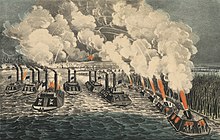Mississippi River campaigns
The Mississippi River campaigns, within the
The campaign on and along the Mississippi River started in February 1862 with Union forces pushing down from Cairo, Illinois into disputed territory in Missouri and Kentucky and Confederate territory in Tennessee. It ended with the surrender of the last Confederate strongholds on the Mississippi River, Vicksburg, Mississippi on July 4, 1863 and of Port Hudson, Louisiana on July 9, 1863. Flag Officer Foote initially commanded the Union naval forces, which were later led by Farragut and Porter.
Background
In July 1863, the
The original Union Army expedition to control the Cumberland and Tennessee Rivers was under the overall command

Practical elements of warfare on the Mississippi
Although an important role in the Mississippi River campaign was played by armored paddle steamers, the campaign was a Union Army undertaking, as the ships used were under Army command and were used as army transports and floating gun stations rather than independent warships. Most of their boats were either converted paddle steamers or purpose-built gunboats that had never seen the sea. Because of this, the Mississippi River Squadron quickly became known as the Brown-water navy. This was a reference to the brown, muddy water of the Mississippi, as compared to the deep blue commonly associated with the sea. The only exception was at the Siege of Vicksburg where the army, marching downstream met up with the Union Navy under Rear Admiral David Farragut sailing upstream and the two combined their forces for an all-out land-and-sea shelling of the town.
The river campaigns saw the first practical use of river gunboats and river ironclads, in particular the
Notable engagements
Important battles in the Tennessee and Cumberland Rivers campaign were the capture of
See also
- Mississippi River in the American Civil War
- Seth Ledyard Phelps (commander of various gunboat fleets)
- Charles Henry Davis (replaced Admiral Foote as flag officer of Mississippi Squadron)
Sources
- Arnold, James R. Grant Wins the War: Decision at Vicksburg. New York: John Wiley & Sons, Inc., 1997. ISBN 978-0-471-15727-4.
- Ballard, Michael B. Grant at Vicksburg: The General and the Siege. Carbondale, IL: Southern Illinois University Press, 2013. ISBN 978-0-8093-3240-3.
- Ballard, Michael B. Vicksburg, The Campaign that Opened the Mississippi. Chapel Hill: University of North Carolina Press, 2004. ISBN 978-0-8078-2893-9.
- ISBN 978-0-89029-312-6.
- Beck, Brandon H. Holly Springs: Van Dorn, The CSS Arkansas and The Raid That Saved Vicksburg. Charleston, SC: The History Press, 2011. ISBN 978-1-60949-049-2.
- Carter III, Samuel. The Final Fortress: The Campaign for Vicksburg 1862-1863. New York, St. Martin's Press, 1980. ISBN 978-0-312-83926-0.
- ISBN 978-0-671-46990-0.
- Cooling, Benjamin Franklin. Forts Henry and Donelson: The Key to the Confederate Heartland. Knoxville: University of Tennessee Press, 1987. ISBN 978-0-87049-538-0.
- Daniel, Larry J. and Lynn N. Bock. Island No. 10: Struggle for the Mississippi Valley. Tuscaloosa: The University of Alabama Press, 1996. ISBN 978-0-8173-0816-2.
- ISBN 978-0-684-84944-7.
- Esposito, Vincent J. West Point Atlas of American Wars. New York: Frederick A. Praeger, 1959. OCLC 5890637. The collection of maps (without explanatory text) is available online at the West Point website.
- ISBN 978-0-394-41951-0.
- ISBN 978-0-8117-3160-7. Originally published 2003.
- ISBN 0-914427-67-9.
- Hamilton, James. The Battle of Fort Donelson. South Brunswick, NJ: T. Yoseloff, 1968. OCLC 2579774.
- Joiner, Gary D. Mr. Lincoln's Brown Water Navy: The Mississippi Squadron. Lanham, MD: Rowman & Littlefield Publishers, Inc., 2007. ISBN 978-0-7425-5098-8.
- Kennedy, Frances H., ed. The Civil War Battlefield Guide. 2nd ed. Boston: Houghton Mifflin Co., 1998. ISBN 978-0-395-74012-5.
- Kerby, Robert L. Kirby Smith's Confederacy: The Trans-Mississippi South, 1863– 1865. Tuscaloosa and London: The University of Alabama Press, Reprint. Originally published New York: Columbia University Press, 1972. ISBN 978-0-8173-0546-8.
- Korn, Jerry, and the Editors of Time-Life Books. War on the Mississippi: Grant's Vicksburg Campaign. Alexandria, VA: Time-Life Books, 1985. ISBN 0-8094-4744-4.
- Knight, James R. The Battle of Fort Donelson: No Terms but Unconditional Surrender. Charleston, SC: The History Press, 2011. ISBN 978-1-60949-129-1.
- ISBN 978-0-19-503863-7.
- ISBN 978-0-8078-3588-3.
- Nevin, David, and the Editors of Time-Life Books. The Road to Shiloh: Early Battles in the West. Alexandria, VA: Time-Life Books, 1983. ISBN 0-8094-4716-9.
- Shea, William L. and Terrence J. Winschel. Vicksburg is the Key: The Struggle for the Mississippi River. Lincoln, NE: University of Nebraska Press, 2003. ISBN 978-0-8032-9344-1.
- Simon, John Y., ed. Papers of Ulysses S. Grant: January 8 - March 31, 1862. Vol. 4. Carbondale: Southern Illinois University Press, 1972. ISBN 0-8093-0507-0.
- ISBN 0-8093-0884-3.
- ISBN 0-684-84927-5.
- Smith, Timothy B. Champion Hill: Decisive Battle for Vicksburg. El Dorado Hills, CA: Savas Beatie, 2004. ISBN 978-1-932714-00-5.
- Taafe, Stephen R. Commanding Lincoln's Navy: Union Naval Leadership During the Civil War. Annapolis, MD: Naval Institute Press, 2009. ISBN 978-1-59114-855-5.
- Tucker, Spencer C. Blue & Gray Navies: The Civil War Afloat. Annapolis, MD: Naval Institute Press, 2006. ISBN 978-1-59114-882-1.
- Winschel, Terrence J. Triumph & Defeat: The Vicksburg Campaign. New York: Savas Beatie LLC, 2004. ISBN 978-1-932714-04-3. First published Campbell, CA, Savas Publishing Co., 1999.
- ISBN 978-0-8071-0834-5.
- Woodworth, Steven E. Nothing but Victory: The Army of the Tennessee, 1861–1865. New York: Alfred A. Knopf, 2005. ISBN 978-0-375-41218-9.
- Woodworth, Steven E., and Charles D. Grear. The Vicksburg Campaign, March 29–May 18, 1863. Carbondale, IL: Southern Illinois University Press, 2013. ISBN 978-0-8093-3269-4.
